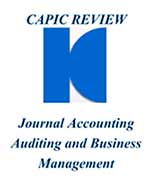Fair value and the quality of information disclosure: effects of the early adoption of IFRS 13 in Chile
Published 2015-12-10
Keywords
- Asymmetry of information,
- fair value hierarchy,
- spread (bid-ask)
How to Cite
Abstract
The Chilean capital market is characterized by high concentration of ownership and the participation of institutional investors such as Pension Funds (AFP). In Chile, the IFRS are adopted from the year 2009. Since the issuance of IFRS 13, in 2011, its application has been voluntary, and only mandatory from 2013. The purpose of this study is to measure the impact of the early adoption of the use of fair value in the transparency of the Chilean capital market and the reduction of information asymmetry.
As a proxy of information asymmetry will be used the spread (bid-ask) with intra-day data of the Santiago Stock Exchange for the period 2007-2012.
The study shows that the early adoption of IFRS 13 has not produced significant effect on the asymmetry of information, it is further appreciated that the application of the standard has not pro-duced the expected effect, that is, at lower level of fair value hierarchy less asymmetry of information.
Downloads
References
2. Assidi, S. & Omri, M. A. (2012). IFRS and Information Quality: Cases of CAC 40 Companies. Global. Journal of Management and Business Research, 12(19), 72-83.
3. Bakhshi, M., Bazrafshan, E., Rezaei, M. & Fereidouni, H.G. (2011). The Impact of Corporate Governance on the Bid-Ask Spread: Evidence from an Emerging Market. International Conference on Sociality and Economics Development IPEDR, volumen 10, IACSIT Press, Singapore. Recuperado de http://www.ipedr.com/vol10/97-S10064.pdf
4. Barth, M. & Landsman, W. (2010). How did financial reporting contribute to the Financial Crisis? European Accounting Review, 19(3), 399-423.
5. Barth, M. Landsman, W., Lang, M. & Williams, C. (2012). Are IFRS-based and US GAAP-based Accounting Amounts Comparable?. Journal of Accounting & Economics, 54(1), 68-93.
6. Botosan, C. A. (1997). Disclosure Level and The Cost of Equity Capital. The Accounting Review, 72(3), 323-349.
7. Chen, W. P., Chung, H., Lee, C. & Liao, W.L. (2007). Corporate Governance and Equity Liquidity: analysis of S&P transparency and disclosure rankings. Corporate Governance: An International Review, 15(4), 644-660.
8. Clarkson, P., Hanna, J., Richardson, G. & Thompson, R. (2011). The impact of IFRS adoption on the value relevance of book value and earnings. Journal of Contemporary Accounting and Economics, 7(1), 1-17.
9. Copeland, T. E. & Galai, D. (1983). Information Effects on the Bid-Ask Spread. The Journal of Finance, 38(5), 1457-1469.
10. De la Fuente, H.; Campos, R.; Silva, B. & Cademartori, D. (2013). “An econometric analysis for the behavior of the bid-ask spread”. Open Journal of Social Sciences, vol. 1(7), pp. 1-5.
11. Dennis, P. & Weston, J. (2001). Who’s Informed? An Analysis of Stock Ownership and Informed Trading (June 4, 2001). AFA 2002 Atlanta Meetings. Available at SSRN: http://ssrn.com/abstract=267350 or http://dx.doi.org/10.2139/ssrn.267350
12. Erwin, G. R. & J. M. Miller (1998). The liquidity effects associated with addition of a stock to the S&P 500 index: evidence from bid/ask spreads. The Financial Review. 33, 131-146
13. Florou, A. & Pope, P. (2012). Mandatory IFRS Adoption and Institutional Investment Decisions. The Accounting Review, 87(6), 1993-2025.
14. Gjerde, T., Mahenthiran, S. &Cademartori, D. (2013). Effect of Ownership, Governance, and Transparency on Liquidity-Chilean Evidence. Journal of Contemporary Accounting & Economics, 9(2), 183-202.
15. Glosten, L. R. & Harrris, L. E. (1988). Estimating the Components of the BID/ASK Spread. Journal of Financial Economics, 21(1), 123-142.
16. Haat, H. M., Mahenthiran, S., Rahman A. R. & Hamid A. N. (2006). Agency Costs as a Factor in the Suspension of Companies from the Kuala Lumpur Stock Exchange, Journal of Contemporary Accounting and Economics, 2(1), 99-121.
17. He, X. Wong, T.J. & Young, D. (2012). Challenges for implementation of fair value accounting in emerging markets: evidence from China. Contemporary Accounting Research, 29(2), 538-562.
18. Healy, P. M. & Palepu, K. G. (2001). Information asymmetry, corporate disclosure, and the capital markets: A review of the empirical disclosure literature. Journal of Accounting and Economics, 31(1-3), 405-440.
19. International Accounting Standards Board IASB (2011). Norma Internacional de Información Financiera 13. Medición del Valor Razonable.
20. Kanagaretnam, K., Lobo, G. & Whalen, D. (2007). Does good corporate governance reduce information asymmetry around quarterly earnings announcements? Journal of Accounting and Public Policy, 26(4), 497-522.
21. Kim, O & Verrecchia, R. (1994). Market liquidity and volumen around earnings announcements. Journal of Accounting and Economics, 17, 41-67.
22. Liao, Kang, Morris & Tang. (2013). Information asymmetry of fair value accounting during the financial crisis. Journal of Contemporary Accounting & Economics, 9(2), 221-236.
23. Maug, E.G. (2002). Insider Trading Legislation and Corporate Governance. European Economic Review, 46(9), 1569-1597.
24. Munteanu, L. (2011). Cost of Equity, Financial Information Disclosure, and IFRS adoption: A Literature Review. Internal Auditing & Risk Management, 4(24), 67-80.
25. Muller, K., Riedl, E. & Sellhorn, T. (2011). Mandatory Fair Value Accounting and Information Asymmetry: Evidence from the European Real Estate Industry. Management Science, 57(6), 1138-1153.
26. Organización para la Cooperación y el Desarrollo Económico (OCDE). (2011). Fortaleciendo el Gobierno Corporativo Latinoamericano. El papel de los inversionistas institucionales, 1-80.
27. Rubin, A. (2007). Ownership Level, Ownership Concentration and Liquidity. Journal of Financial Markets, 10(3), 219-248.
28. Sarin, A., Shastri, K. & Shastri, K. (1996). Ownership structure and stock market liquidity. Disponible en SSRN: http://ssrn.com/abstract=2652
29. Song, C. J., Thomas W. B. &Yi, H. (2010) Value Relevance of FAS No. 157 Fair Value Hierarchy Information and the Impact of Corporate Governance Mechanisms. The Accounting Review, 85(4), 1375-1410.
30. Venkatesh, P.C. & Chiang, R. (1986). Information Asymmetry and the Dealer’s Bid-Ask Spread: A Case Study of Earnings and Dividend Announcements. Journal of Finance, 41(5), 1089-1102.


































